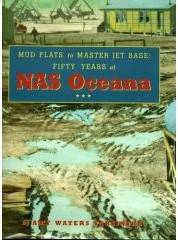
Mud Flats to Master Jet Base: Fifty Years at NAS Oceana, by Amy Waters Yarsinske, captures how in the 1880s, a whistle stop named Tunis was the only oasis of civilization on the Norfolk Southern Railway spur between already-urban Norfolk and the popular Virginia Beach oceanfront became the hub of Naval Aviation activity. Everything in-between was sprawling farmland. Homes and a couple of country stores eventually sprouted around the next-to-last stop in Princess Anne County and, to give it a name more appropriate to the train’s destination, the hamlet at Tunis was renamed Oceana in 1891.
By 1938, with the threat of war a real possibility, the Navy had only the air station at Norfolk and two grass auxiliary fields for its aviators to practice. Then-Rear Admiral Patrick Neison Lynch Bellinger, commander in chief, Naval Air Force Atlantic, received orders to locate, acquire and build out four additional fields around Norfolk. “Because they had so damn many pilots to train so fast,” recalled retired captain Dexter C. Rumsey II, who would command Oceana in the years that followed World War II.
Between the village of Oceana and the Princess Anne County Courthouse lay 5,000 acres of farmland from which the air station eventually sprang. The Navy’s choice of this vast tract was purposeful. With low population density and plenty of elbowroom, the parcel was the perfect location for a military airfield. Oceana would become, quite literally, an air station that had a city grow around it, not the other way around.
Immediately after President Franklin D. Roosevelt declared war against Japan and Germany, naval personnel descended on the muddy field of auxiliary landing field Oceana, erecting a series of 19 Quonset huts to accommodate 32 officers and 172 enlisted personnel. Emerging from the mud flats on that isolated landscape, Oceana became a master jet base as vital to national defense today as it was at the outset of World War II.
Each decade beginning with Pearl Harbor has seen such threats to world peace as the Korean and Vietnam conflicts, the cold war, the Cuban Missile Crisis, trouble in Lebanon and Libya, and the Persian Gulf War [the last conflict covered in this book, which was published in 2001].
A once-remote airbase initially designed to accommodate World War II-period dogfighting fighter planes and attack aircraft, Oceana is now the largest tactical fighter base – serving the most sophisticated military aircraft and their aircrews – in the world. Through hundreds of interviews, rare photographs and the exhaustive research that is her hallmark, author, aviation expert and historian Amy Waters Yarsinske in Mud Flats to Master Jet Base: Fifty Years at NAS Oceana, tells the stories of vision, courage and commitment that will convince even Oceana’s worst critics that the master jet base is not only a good neighbor but the region’s – and the nation’s – most vital asset.
Copyright © 2001 by Amy Waters Yarsinske
Get your copy of Mud Flats to Master Jet Base: Fifty Years at NAS Oceana, by Amy Waters Yarsinske today, available at Amazon